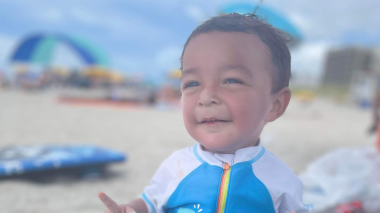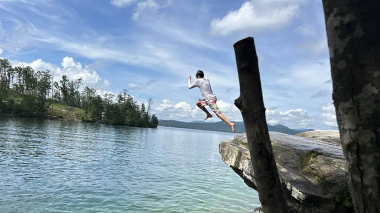At the tender age of 7, Charlie, was already used to wearing a back brace and was expecting years of surgeries to correct her scoliosis.
But her doctors at Levine Children’s Hospital introduced a surgical procedure that reshaped her future. The procedure did away with the traditional treatment, which required frequent surgeries that implanted rods of increasing size. Instead, Charlie had a single surgery implanting a magnetic rod – one that can be lengthened bit by bit via remote control in short outpatient visits. Within days of her surgery, Charlie was home. Within weeks, she’d gained three inches in height and was back to her favorite activity: gymnastics.
Celebrating its 10th anniversary this month, the Levine Children’s Pediatric Orthopedic department is recognized as one of nation’s best by U.S. News & World Report.
“We are on the cutting edge of technology,” says Brian Scannell, MD, medical director of the pediatric orthopedics program. “Our department has continued to grow and incorporate advances.” In fact, with nearly 10,000 annual outpatient visits, LCH orthopedic specialists have successfully treated virtually every kind of complex case.
Over the last 10 years, spinal surgical techniques – like the one performed on Charlie – and post-operative pain management have improved. Complications like infections and hospital readmissions have decreased. And a hospital stay is at least two full days shorter than it was a decade ago. Similarly, advanced techniques to adjust leg-length discrepancies no longer require external pins or wires. Instead, a magnetically controlled lengthening device can add up to 8 centimeters of length.
The orthopedic program relies on LCH’s Level I pediatric trauma center – the only one of its kind in the greater Charlotte area – excelling in the speed at which patients from all over the state get to the operating room and beyond. And just this past August, LCH launched one of the nation’s first Pediatric Trauma Survivors Network programs. This comprehensive team of healthcare professionals, from trauma neurosurgery and rehabilitation specialists to social workers, offers support and resources for trauma patients and their families.
Next on the agenda?
Dr. Scannell envisions a nurse navigator program – orthopedic nurses who can offer individualized educational, logistical and other assistance to patients and families – as part of the team. “Having that go-to person is key,” he says. But even without that addition, it’s clear that patients like Charlie already have a go-to team in the LCH orthopedics program.
But her doctors at Levine Children’s Hospital introduced a surgical procedure that reshaped her future. The procedure did away with the traditional treatment, which required frequent surgeries that implanted rods of increasing size. Instead, Charlie had a single surgery implanting a magnetic rod – one that can be lengthened bit by bit via remote control in short outpatient visits. Within days of her surgery, Charlie was home. Within weeks, she’d gained three inches in height and was back to her favorite activity: gymnastics.
Celebrating its 10th anniversary this month, the Levine Children’s Pediatric Orthopedic department is recognized as one of nation’s best by U.S. News & World Report.
“We are on the cutting edge of technology,” says Brian Scannell, MD, medical director of the pediatric orthopedics program. “Our department has continued to grow and incorporate advances.” In fact, with nearly 10,000 annual outpatient visits, LCH orthopedic specialists have successfully treated virtually every kind of complex case.
Technology and Teamwork
It wasn’t long ago that the LCH orthopedics department had to send certain patients to other facilities for care. Today, the team-based program offers care for the full range of pediatric and adolescent conditions.Over the last 10 years, spinal surgical techniques – like the one performed on Charlie – and post-operative pain management have improved. Complications like infections and hospital readmissions have decreased. And a hospital stay is at least two full days shorter than it was a decade ago. Similarly, advanced techniques to adjust leg-length discrepancies no longer require external pins or wires. Instead, a magnetically controlled lengthening device can add up to 8 centimeters of length.
The orthopedic program relies on LCH’s Level I pediatric trauma center – the only one of its kind in the greater Charlotte area – excelling in the speed at which patients from all over the state get to the operating room and beyond. And just this past August, LCH launched one of the nation’s first Pediatric Trauma Survivors Network programs. This comprehensive team of healthcare professionals, from trauma neurosurgery and rehabilitation specialists to social workers, offers support and resources for trauma patients and their families.
Leading the Way to Tomorrow’s Care
Still another major component of the orthopedics program – one not necessarily experienced firsthand by patients but ultimately an integral part of care – is research and education. “No program can be world-class without them,” says Dr. Scannell. That includes teaching the next generation of pediatric orthopedists on a daily basis and publishing results of clinical research. The LCH orthopedics department continues to lead the LCH pediatric division with respect to the number of publications and regional, national and international presentations.Next on the agenda?
Dr. Scannell envisions a nurse navigator program – orthopedic nurses who can offer individualized educational, logistical and other assistance to patients and families – as part of the team. “Having that go-to person is key,” he says. But even without that addition, it’s clear that patients like Charlie already have a go-to team in the LCH orthopedics program.



